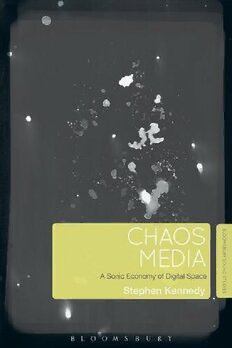
Chaos Media: A Sonic Economy of Digital Space PDF
Preview Chaos Media: A Sonic Economy of Digital Space
Chaos Media i ii Chaos Media A Sonic Economy of Digital Space Stephen Kennedy Bloomsbury Academic An imprint of Bloomsbury Publishing Inc iii Bloomsbury Academic An imprint of Bloomsbury Publishing Inc 1 385 Broadway 50 Bedford Square New York London NY 10018 WC1B 3DP U SA UK www.bloomsbury.com BLOOMSBURY and the Diana logo are trademarks of Bloomsbury Publishing Plc First published 2015 © Stephen Kennedy 2015 All rights reserved. No part of this publication may be reproduced or transmitted in any form or by any means, electronic or mechanical, including photocopying, recording, or any information storage or retrieval system, without prior permission in writing from the publishers. No responsibility for loss caused to any individual or organization acting on or refraining from action as a result of the material in this publication can be accepted by Bloomsbury or the author. Library of Congress Cataloging-i n-Publication Data Kennedy, Stephen. Chaos media : a sonic economy of digital space / by Stephen Kennedy. pages cm Includes bibliographical references and index. ISBN 978-1-62356-706-4 (hardback : alk. paper) 1. Mass media—Philosophy. 2. Digital media—Philosophy. 3. Mass media—Technological innovations. 4. Chaotic behavior in systems. I. Title. P90.K4575 2015 302.2301—dc23 2014027508 ISBN: HB: 978-1-6235-6706-4 ePDF: 978-1-6235-6220-5 ePub: 978-1-6235-6724-8 Typeset by Refi neCatch Limited, Bungay, Suffolk, UK iv For Gemma, Lori, and Erin And in memory of my brother Michael v vi Contents Preface viii Introduction 1 1 Sonic Dimensions 25 2 Territories of Resistance 49 3 Echostate 73 4 An Invisible Exchange 107 5 Motor Cities 135 Bibliography 157 Index 167 vii Preface Th is book is about humans in digital space and how they exist in a chaotic environment where time and space have become fractured and discontinuous. It is about reality, and the real, the virtual, and the imagined. As such, it is a metaphysical enquiry into where we are. Yet it does not privilege the human. It recognizes and takes seriously the contribution of Actor Network Th eory and the importance assigned to non- human factors in complex arrangements. In fact, from a Foucauldian perspective, it engages with an enquiry that describes the movement into the digital age in a manner that is mindful of Bruno Latour’s methodology. It also recognizes the work of the speculative realists and object- orientated philosophers in this regard. Yet it is also a book that is mindful of acknowledging creativity, hence it owes a lot to Henri Bergson and Gaston Bachelard and their attempts to resolve some of the lingering questions around art and aesthetics. Th is is a book about space, digital space. As such, it is concerned with boundaries, thresholds and borders. It is about the inside and the outside of space and place. Yet insofar as it recognizes the constantly changing nature of space, time is never far from its thoughts. How we came to inhabit digital space is an important question, and where this journey will ultimately take us is maybe even more important, but that will have to wait for another time, as it were. Finally, it is a book about sound, about an analogical deployment of the sonic as a means of accounting for the ways in which a ‘one substance cosmology’ gives rise to specifi c events. One such event is the emergence of digital space itself, and as a way of exploring how this came to be, and to show how the variety of theoretical concepts on off er can be mixed into a meaningful solution, the specifi c sounds of both Coventry and Detroit will be triggered. viii Introduction Th e sociological theory that the loss of the support of objectively established religion, the dissolution of the last remnants of pre- capitalism, together with technological and social diff erentiation or specialisation, have led to cultural chaos is disproved every day; for culture now impresses the same stamp on everything. (Adorno and Horkheimer 1997: 120) Do we now live in a period when this chaos can no longer be so easily challenged? We should be clear about the idea of chaos from the outset. When Th eodore Adorno and Max Horkheimer questioned unfounded assumptions about cultural chaos, they were challenging instrumental rationality and the strange idea that where chaos was most visible, order and conformity actually prevailed. Where are we today in this regard? In the 1990s warnings of chaos, anarchy and offi cial impotence in the face of untethered technological change were common. In actuality, such claims turned out to be no more true than at the time of Adorno and Horkheimer’s writing. But what they meant by chaos was something diff erent than the contemporary meaning being employed here. Chaos is not used to describe the anarchic disarray of digital environments but rather to try and show how patterning occurs, not as a fi xed universal phenomenon, but as a relative continuity punctuated by diff erence. Political and economic forces continue to try and impose order on chaos by paradoxically highlighting their own impotence, as will be demonstrated in 1
